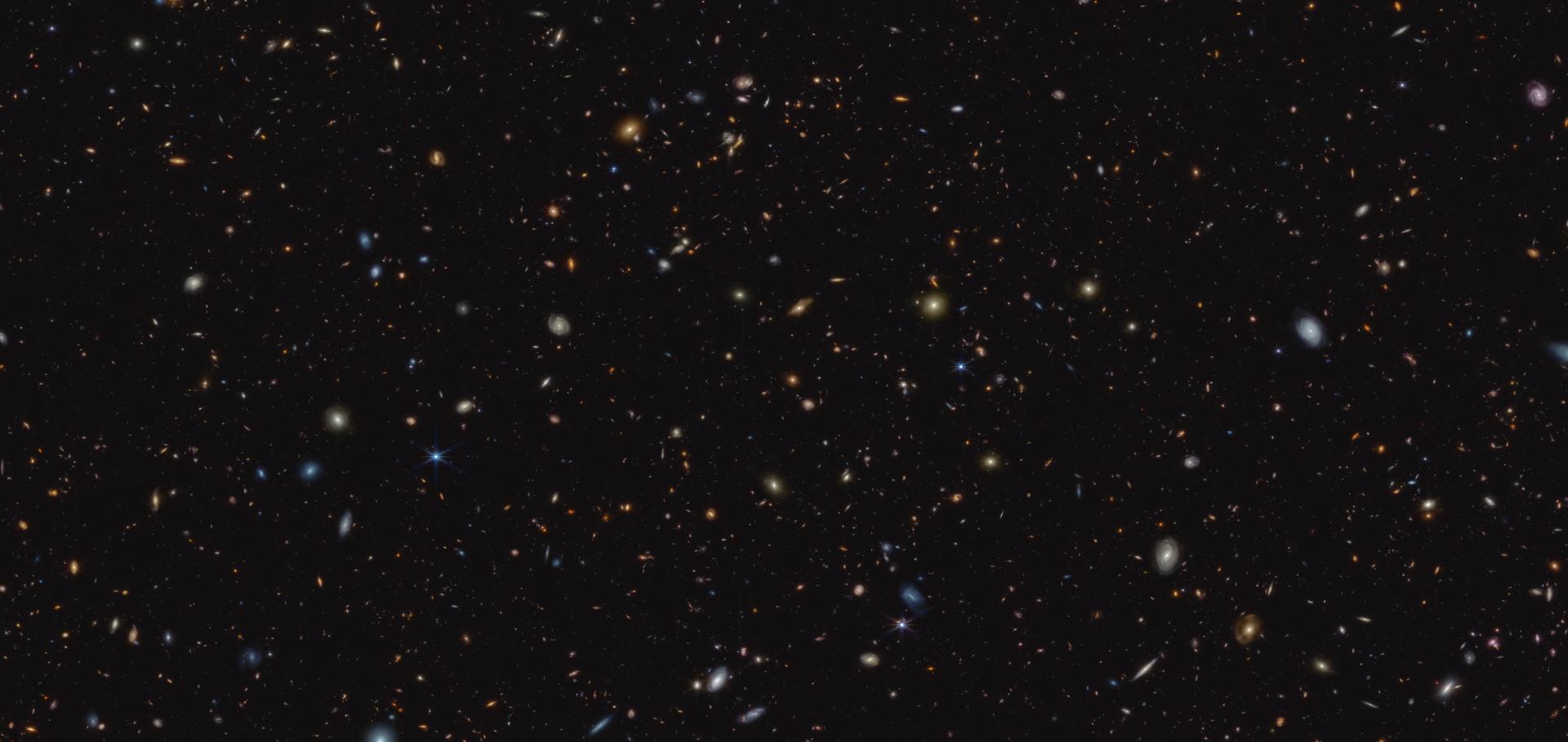The z ≳ 9 Galaxy UV Luminosity Function from the JWST Advanced Deep Extragalactic Survey: Insights into Early Galaxy Evolution and Reionization
The Astrophysical Journal American Astronomical Society 992:1 (2025) 63
Abstract:
The high-redshift UV luminosity function provides important insights into the evolution of early galaxies. JWST has revealed an unexpectedly large population of bright (MUV ≲ −20) galaxies at z ≳ 10, implying fundamental changes in the star-forming properties of galaxies at increasingly early times. However, constraining the fainter population (MUV ≳ −18) has been more challenging. In this work, we present the z ≳ 9 UV luminosity function from the JWST Advanced Deep Extragalactic Survey. We calculate the UV luminosity function from several hundred z ≳ 9 galaxy candidates that reach UV luminosities of MUV ∼ −17 in redshift bins of z ∼ 8.5–12 (309 candidates) and z ∼ 12–16 (63 candidates). We search for candidates at z ∼ 16–22.5 and find none. We also estimate the z ∼ 14–16 luminosity function from the z ≥ 14 subset of the z ∼ 12–16 sample. Consistent with other measurements, we find an excess of bright galaxies that is in tension with many theoretical models, especially at z ≳ 12. However, we also find high number densities at −18 ≲ MUV ≲ −17, suggesting that there is a larger population of faint galaxies than expected, as well as bright ones. From our parametric fits for the luminosity function, we find steep faint-end slopes of −2.5 ≲ α ≲ −2.3, suggesting a large population of faint (MUV ≳ −17) galaxies. Combined, the high normalization and steep faint-end slope of the luminosity function could imply that the reionization process is appreciably underway as early as z = 10.Detection of the 2175 Å UV bump at z > 7: evidence for rapid dust evolution in a merging reionization-era galaxy
Monthly Notices of the Royal Astronomical Society Oxford University Press 542:2 (2025) 1136-1154
Abstract:
Dust is a fundamental component of the interstellar medium within galaxies, as dust grains are highly efficient absorbers of ultraviolet (UV) and optical photons. Accurately quantifying this obscuration is crucial for interpreting galaxy spectral energy distributions (SEDs). The extinction curves in the Milky Way (MW) and Large Magellanic Cloud exhibit a strong feature known as the 2175 Å UV bump, most often attributed to small carbonaceous dust grains. This feature was recently detected in faint galaxies out to , suggesting rapid formation channels. Here, we report the detection of a strong UV bump in a luminous Lyman-break galaxy at , GNWY-7379420231, through observations taken as part of the NIRSpec Wide GTO survey. We fit a dust attenuation curve that is consistent with the MW extinction curve within , in a galaxy just Myr after the big bang. From the integrated spectrum, we infer a young mass-weighted age ( Myr) for this galaxy, however spatially resolved SED fitting unveils the presence of an older stellar population ( Myr). Furthermore, morphological analysis provides evidence for a potential merger. The underlying older stellar population suggests the merging system could be pre-enriched, with the dust illuminated by a merger-induced starburst. Moreover, turbulence driven by stellar feedback in this bursty region may be driving polycyclic aromatic hydrocarbon formation through top-down shattering. The presence of a UV bump in GNWY-7379420231 solidifies growing evidence for the rapid evolution of dust properties within the first billion years of cosmic time.JADES – the small blue bump in GN-z11: insights into the nuclear region of a galaxy at z = 10.6
Monthly Notices of the Royal Astronomical Society Oxford University Press 541:3 (2025) 2134-2161
Abstract:
We report the detection of continuum excess in the rest-frame ultraviolet (UV) between 3000 and 3550 Å in the JWST/Near Infrared Spectrograph (NIRSpec) spectrum of GN-z11, a luminous galaxy . The shape of the continuum excess resembles a Balmer continuum, but has a break around 3546 Å. The fitting result of this excess depends on the assumed origin of the continuum. If the continuum of GN-z11 is dominated by a stellar population with a small Balmer break, the apparent blueshift of the Balmer continuum is not significant and the best-fitting Balmer continuum model indicates a temperature of K. In contrast, if the continuum is dominated by active galactic nucleus emission, a nebular continuum model cannot fit the spectrum properly. The absence of the Balmer jump indicates an electron temperature of K, significantly higher than the temperature of K inferred from [O iii] and [O iii]. The temperature difference can result from mixing of different ionized regions: the Balmer emission mainly arises from dense and hot clouds in the broad-line region, whereas the forbidden lines originate from less dense and colder gas. An alternative explanation for the observed continuum excess is the Fe ii emission, which shows a characteristic jump blueward of the Balmer limit as previously seen in the spectra of many lower redshift quasars. Through comparisons with cloudy models, we show an Fe abundance above solar is likely needed, which could be achieved via enrichment from Type-Ia supernovae, hypernovae, or pair-instability supernovae.Resolving the nature and putative nebular emission of GS9422: an obscured AGN without exotic stars
Monthly Notices of the Royal Astronomical Society Oxford University Press 540:1 (2025) 851-870
Abstract:
Understanding the sources that power nebular emission in high-redshift galaxies is fundamentally important not only for shedding light on to the drivers of reionization, but to constrain stellar populations and the growth of black holes. Here, we focus on an individual object, GS9422, a galaxy at with exquisite data from the JWST Advanced Deep Extragalactic Survey (JADES), JWST Extragalactic Medium-band Survey (JEMS), and First Reionization Epoch Spectroscopically Complete Observations (FRESCO) surveys, including 14-band JWST/NIRCam photometry and deep NIRSpec prism and grating spectroscopy. We map the continuum emission and nebular emission lines across the galaxy on 0.2-kpc scales. GS9422 has been claimed to have nebular-dominated continuum and an extreme stellar population with top-heavy initial mass function. We find clear evidence for different morphologies in the emission lines, the rest-ultraviolet and rest-optical continuum emission, demonstrating that the full continuum cannot be dominated by nebular emission. While multiple models reproduce the spectrum reasonably well, our preferred model with a type-2 active galactic nucleus (AGN) and local damped Ly (DLA) clouds can explain both the spectrum and the wavelength-dependent morphology. The AGN powers the off-planar nebular emission, giving rise to the Balmer jump and the emission lines, including Ly, which therefore does not suffer DLA absorption. A central, young stellar component dominates the rest-UV emission and – together with the DLA clouds – leads to a spectral turn over. A disc-like, older stellar component explains the flattened morphology in the rest-optical continuum. We conclude that GS9422 is consistent with being a normal galaxy with an obscured, type-2 AGN – a simple scenario, without the need for exotic stellar populations.Zapped then napped? A rapidly quenched remnant leaker candidate with a steep spectroscopic slope at z=8.5
Astronomy & Astrophysics EDP Sciences (2025)


